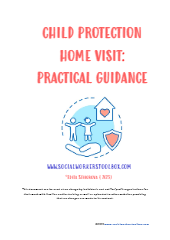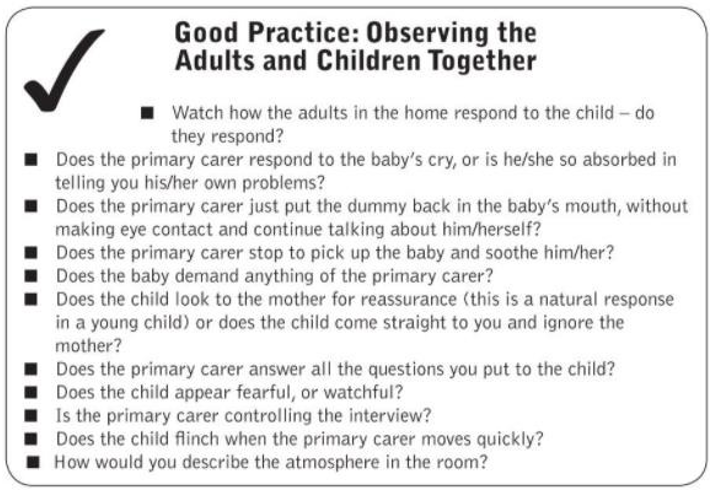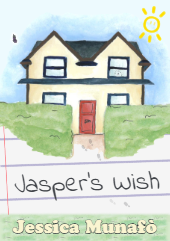(You can download the guidance below in a PDF document here.)
 WHEN THERE IS NO ANSWER WHEN YOU KNOCK:
WHEN THERE IS NO ANSWER WHEN YOU KNOCK:
- If the family does not answer the door when you knock, listen to/observe any signs of people being present in the house. If you believe that somebody is in the property and it is safe to do so (beware of dogs), consider whether it is appropriate to shout through the letterbox that you are aware that the family is in the house and are waiting for them to answer the door.
- When possible, have a look in the garden to ensure that the family is not there. If possible, also knock on the back door.
- Call the family on their mobile phone to ask where they are, and to see if you can hear the phone ringing inside the house.
- If nobody answers the door, post a note with details of your next visit.
- If the purpose of your visit is to check whether there has been a breach of an agreement that a specific person does not visit the family home, it is advisable to take a second worker who can observe whether the person leaves the house from a back door whilst you are knocking at the front.
WHEN IN THE FAMILY HOME:
Record details of all people present
Record details of all people present; this includes people who live in the house as well as any visitors who are there at the time of your visit – ask the visitors for their name and relationship to the family. If the child subject to a Child Protection Plan has regular contact with them, ask for their address and DOB so that you can record them on the system. If the adult visitor regularly cares for the child or stays in the child’s family home overnight, ask for their consent for you to complete a police check on them.
If any unknown person refuses to give you their details, request the details from the parents. If not established, record the description of this person.
Establish the whereabouts of the children subject to a Child Protection Plan who are not at home
If the child who you have come to see is not at home, ask about their exact whereabouts and who they are with. If there are concerns about their level of supervision or you have any concerns that the child might be at risk, ask for evidence of their whereabouts – for example, if the child is said to be with another adult, can you call the other adult and ask to speak to the child on the phone; can the adult who is present take you to see the child; can you call the child on their mobile phone and meet them where they are?
If you do not manage to see the child at home during your visit, arrange to see the child at home within statutory timescales on a different occasion. If you are, however, concerned about the child’s safety or well-being on that day, ensure that you make contact with the child on the same day of your visit – this (depending on the level of your concerns) may be a telephone/WhatsApp video call, pre-arranged later home visit or (when appropriate) arrange a visit by the “Out of Hours” team.
Observe the child/young person
- What’s the child’s physical presentation (appropriateness of clothes, level of hygiene, signs of injury; do they present healthy or ill)?
- What’s the child’s emotional presentation and behaviour?
- What is the child doing during the whole duration of the visit?
- How does the child respond to their family members and other people in the house?
Depending on the nature of the case and concerns, you may need to dedicate some of your visits to conduct more comprehensive observations so you can assess factors such as the child’s attachment to their main carer, the child’s level of development, the family’s functioning, the child’s daily routine etc.
You may find the following tools useful:
- Ages & Stages Questionnaire is a child development screening tool for children aged 2 months to 5 It is widely used by health visitors when assessing children’s development, however, it makes a useful tool to support other practitioner’s observation of non-verbal and pre-school children as well. Print the relevant questionnaire depending on the child’s age and take it with you to the family – observe the child together with their parent(s) and fill it in together. Older siblings often enjoy helping fill in the questionnaire in relation to their younger children too.
- There is also Ages and Stages Social-Emotional Development Screening Tool which looks at how children are doing in areas, such as self-regulation, communication, autonomy, compliance, adaptive functioning, affect, and interaction with people.
- Observations Checklist: Assessing Attachment and Bonding. The checklist outlines what behaviours in children from birth to adolescents and parents/carers an observer should look for when assessing a child’s attachment style.
- Joanna Nicolas in her book ‘Conducting the home visit in child protection’ (and her newer version) recommends that the assessors consider the following:

Talk to the child/young person alone
With pre-school children (3 & 4 years), you may first try to establish trust by playing with them in presence of their main carer, then you can ask them to show you their bedroom by themselves. There, if they feel comfortable with you, you can conduct direct work with them, adjusting it to their chronological and mental age. If the child does not feel safe to see you without their parent/carer, you should still conduct direct work in their parent’s presence.
Examples of direct work:
- When in their bedroom, ask the child to show you things in their bedroom – their bed, toys, posters etc. – try to ascertain their likes and dislikes, what they do during the day etc.
- Bring some toys which can facilitate a conversation about what their daily experience is like, for example dolls or puppets, doll house, crafts etc.
- Give the child a sheet with pictures depicting a typical daily routine and ask them to point to those they do every day – depending on their level of understanding/speech, you can then ask more questions about the pictures they point to.
With older children, conduct direct work aimed at establishing what their day-to-day life looks like as well as at ascertaining their views, wishes and feelings
(see www.socialworkerstoolbox.com/category/wishes-feelings-2/ for examples of tools you can use). In addition, focus your direct work on the area of risk/need you have identified.
In most cases, it is important that you also complete direct work with the child/young person outside the family, e.g. in their school.
See sleeping children
You should see any sleeping child subject to a Child Protection Plan. Only wake a baby in extreme circumstances such as when it is your job to weigh the baby or examine the baby as part of the child protection work. Depending on the level and nature of concerns, schedule another home visit soon to ensure that you see the child awake as well.
Ask if you can hold a baby
Having made eye contact with and cooed at the baby, ask the primary carer if you can hold her/him. Observe how responsive the baby is, whether the baby looks for his/her primary carer for reassurance, whether the primary carer hands the baby over without a care etc. Look out for any physical injuries, eg. observe whether the baby has a limb that hangs awkwardly or whether the baby cries out when you move him/her.
Observe adults & children not subject to a Child Protection Plan
- What is their physical and emotional presentation?
- What are they doing during your visit?
- What is their interaction with the child subject to a CP plan; do they respond to him/her?
- How do they respond to you and other people in the house?
- Are they co-operative, difficult or hostile?
- Pay attention to any areas which have been identified as issues such as evidence of alcohol or drug use, mental health difficulties, domestic abuse etc.
- What is the atmosphere in the house (eg. chaotic, calm and positive)?
- Observe how the animals in the home look and act (there are strong links between the abuse of animals and the abuse of children and women).
Address any identified safeguarding concerns & Child protection planning
Prior to your visit, you should have considered what the purpose of the visit is in terms of making progress in accordance with the Child Protection Plan. Discuss the progress with the parents (and when relevant, the child) accordingly, highlighting both strengths as well as remaining outstanding needs/risks; agree next steps.
If you identify any new safeguarding concerns during your visit, be honest and inform the parents (and when relevant, the child) about them and agree a plan on how the parents/family can address them (this may be agreeing a specific task such as tiding up the kitchen by your next visit or, when more complex, arranging another appointment specifically dedicated to discussing the newly identified concerns).
If you have any immediate and significant safeguarding concerns (such as children presenting with a potential non-accidental injury) and you need to leave the child in the presence of a potentially unsafe adult (eg. when you need to call your manager from your car or speak to each adult in the house separately), arrange for a second worker to come to the house. The second worker can stay with the child and ensure their safety while you are dealing with the issue.
Look around the house & assess home conditions
- See all the rooms in the house.
- Depending on the level and nature of concerns (such as missing children, a suspected person posing a risk in the family home), you may also need to look at places such as basement, garden shed, wardrobes and under beds.
- What are the home conditions like? Ask for consent to take photos to record your concerns/any progress made.
- Look for anything unusual in the physical appearance of the home (such as punch holes in walls which may indicate violence in the house; locks on doors).
- Is there evidence of food in the fridge and cupboards, clean bedding, stock of clean and appropriate children’s clothes, toiletries and toothbrushes, toys etc?
- Depending on the nature of concerns, you will need to investigate the home further– for example, in alcohol abuse cases, additional investigations of alcohol stocks, bins and cupboards will be useful.
- Assess sleeping arrangements for the child.
- If home conditions are a concern, schedule another home visit to conduct a more comprehensive assessment – you may find the Home conditions observation record/framework or the Risk assessment
Child answering the door/at home without a safe supervisor
There is no legal age that a child can be left alone – it depends on the child and the circumstances. You need to make a judgement whether it is safe for the child to be left alone or be cared for by their older sibling; you need to call your manager for advice if you are unsure.
If you assess the child being at home by themselves as low risk, rearrange the appointment.
If the child is left at home without an appropriate supervisor and you assessed the child as being at risk of significant harm, you can either wait for a short period of time until their parent arrives (if safe) or call the police (if the child is in immediate danger or there is no indication what time their parent will be back home/the parent has not arrived despite you waiting).
If the child answers the door, stating the parent is in the house, ask them to go and get them while you wait on the doorstep. If they say they cannot get their parent because they are, for example, sleeping and and you have concerns about the child’s well-being or safety, you need to ensure that both parent and child are OK. If you have no concerns for your personal safety, go into the home with the child, calling the parent loudly; if they are in a bedroom, knock on the door loudly, calling their name until they wake up. If you have concerns for your personal safety, ring the police and stay there with the child until the police arrive.
Ask for evidence
During the visit, do not rely on self-reported accounts by the family members – ask for evidence. For example, when a pregnant woman tells you that she had made all the practical preparations for the child, ask to see them.
Remember that some parents/carers are known to have gone to great lengths to disguise their neglect and abuse of children. For example, Baby P’s (Peter Connelly) bruises were reported to be purposefully covered in chocolate by his parent/carer to avoid detection. Some parents, especially those misusing substances, are known to give their children illicit or prescribed drugs to keep their children quiet so that they are easier to look after. Co-sleeping practice, which is linked to a higher risk of death, is not uncommon.
Read up on serious case reviews to familiarise yourself with further examples and adjust your investigations and interventions accordingly – you need to be thorough to keep children safe by, for example, asking the adults to wash any stains from their child’s skin, ensuring that you see the child regularly awake, looking for signs of the children’s cots being actually used etc.
FURTHER GOOD PRACTICE ADVICE:
- Read the file before your first speak to other agencies and previous workers.
- Do an assessment of risk in relation to yourself.
- Inform your team where you are going and what time you will be back.
- Conduct both announced and unannounced home visits.
- If you are doing a joint visit, plan with your co-visitor before you go on who will do each task and/or take the lead.
- Before your visit, plan the purpose of your visit.
- Find out if there are any racial/ethnicity/cultural issues and plan your visit accordingly. Book a face-to-face interpreter when required. Save details for a telephone interpreting service to your phone and find out how to use it in advance.
- Be aware of any disabilities or additional needs of the child or family members, and make necessary accommodations, such as using visual aids or providing sign language interpreters.
- Do not discuss any confidential information in front of any visitors in the family home – ask to speak to parents and children alone.
- Be aware of your own biases and attitudes, and strive to remain objective and non-judgmental in your interactions with the family.
- Take notes during the visit, including any observations, concerns, or agreements made with the family, and record them in accordance with your agency’s policy.
FREE PDF DOWNLOAD OF CHILD PROTECTION HOME VISIT: PRACTICAL GUIDANCE








